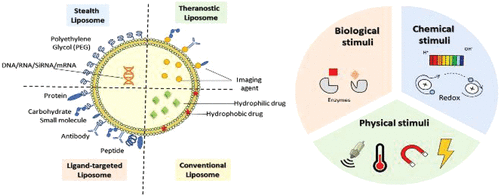当前位置:
X-MOL 学术
›
ACS Pharmacol. Transl. Sci.
›
论文详情
Our official English website, www.x-mol.net, welcomes your feedback! (Note: you will need to create a separate account there.)
Dual-Targeting and Stimuli-Triggered Liposomal Drug Delivery in Cancer Treatment
ACS Pharmacology & Translational Science Pub Date : 2021-06-01 , DOI: 10.1021/acsptsci.1c00066 Nour AlSawaftah 1 , William G Pitt 2 , Ghaleb A Husseini 1
ACS Pharmacology & Translational Science Pub Date : 2021-06-01 , DOI: 10.1021/acsptsci.1c00066 Nour AlSawaftah 1 , William G Pitt 2 , Ghaleb A Husseini 1
Affiliation

|
The delivery of chemotherapeutics to solid tumors using smart drug delivery systems (SDDSs) takes advantage of the unique physiology of tumors (i.e., disordered structure, leaky vasculature, abnormal extracellular matrix (ECM), and limited lymphatic drainage) to deliver anticancer drugs with reduced systemic side effects. Liposomes are the most promising of such SDDSs and have been well investigated for cancer therapy. To improve the specificity, bioavailability, and anticancer efficacy of liposomes at the diseased sites, other strategies such as targeting ligands and stimulus-sensitive liposomes have been developed. This review highlights relevant surface functionalization techniques and stimuli-mediated drug release for enhanced delivery of anticancer agents at tumor sites, with a special focus on dual functionalization and design of multistimuli responsive liposomes.
中文翻译:

癌症治疗中的双重靶向和刺激触发的脂质体药物递送
使用智能药物递送系统 (SDDS) 将化疗药物递送至实体瘤是利用肿瘤的独特生理学(即结构紊乱、血管渗漏、细胞外基质 (ECM) 异常和淋巴引流受限)来递送抗癌药物并降低全身性副作用。脂质体是此类 SDDS 中最有前途的,并且已针对癌症治疗进行了充分研究。为了提高脂质体在病变部位的特异性、生物利用度和抗癌功效,已经开发了其他策略,例如靶向配体和刺激敏感脂质体。本综述重点介绍了相关的表面功能化技术和刺激介导的药物释放,以增强抗癌药物在肿瘤部位的递送,
更新日期:2021-06-11
中文翻译:

癌症治疗中的双重靶向和刺激触发的脂质体药物递送
使用智能药物递送系统 (SDDS) 将化疗药物递送至实体瘤是利用肿瘤的独特生理学(即结构紊乱、血管渗漏、细胞外基质 (ECM) 异常和淋巴引流受限)来递送抗癌药物并降低全身性副作用。脂质体是此类 SDDS 中最有前途的,并且已针对癌症治疗进行了充分研究。为了提高脂质体在病变部位的特异性、生物利用度和抗癌功效,已经开发了其他策略,例如靶向配体和刺激敏感脂质体。本综述重点介绍了相关的表面功能化技术和刺激介导的药物释放,以增强抗癌药物在肿瘤部位的递送,



























 京公网安备 11010802027423号
京公网安备 11010802027423号